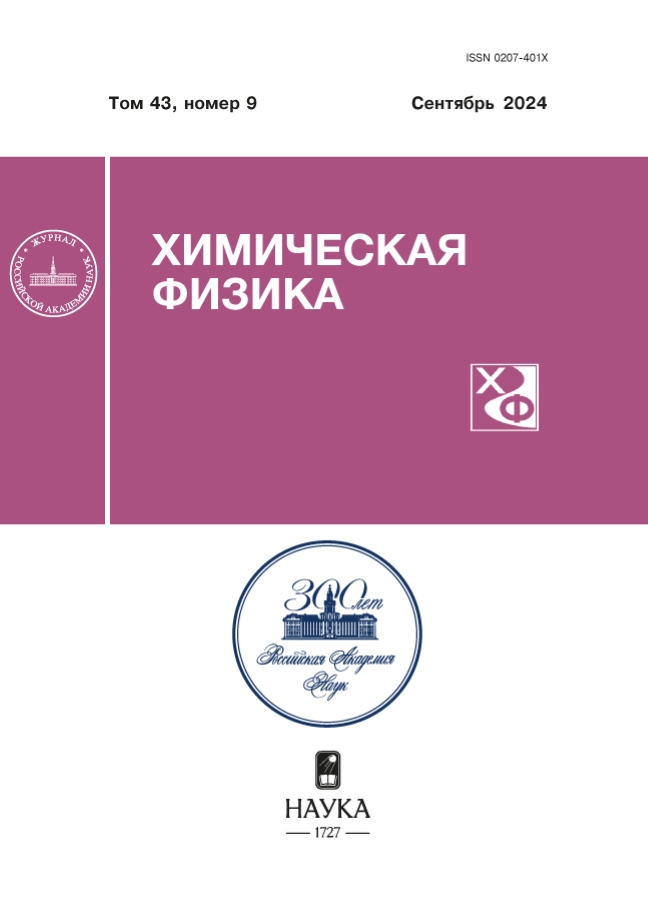Study of the oxidation process of magnetite fluxed pellets by various methods of physical and chemical analysis
- 作者: Yur’ev B.P.1, Dudko V.A.1
-
隶属关系:
- Federal State Autonomous Educational Institution of Higher Education “Ural Federal University named after the first President of Russia B.N.Yeltsin”
- 期: 卷 43, 编号 9 (2024)
- 页面: 42-52
- 栏目: Kinetics and mechanism of chemical reactions, catalysis
- URL: https://kld-journal.fedlab.ru/0207-401X/article/view/680965
- DOI: https://doi.org/10.31857/S0207401X24090059
- ID: 680965
如何引用文章
详细
In order to obtain the most complete information about the processes occurring during the oxidative roasting of magnetite iron ore pellets, comprehensive studies were carried out using various methods of physicochemical analysis. To approximate the assessment of the most probable reactions occurring in pellets during oxidative heating, a thermodynamic analysis was performed. Based on the sign of the isobaric potential, determined from the equation of the isotherm of a chemical reaction, we judged the possibility of a particular chemical reaction occurring in the direction under consideration. The influence on the dissociation reaction of calcium carbonate has been established by the formation of calcium silicates and ferrites, which facilitate its occurrence, as well as the reaction of interaction of iron oxide with calcium carbonate, which, on the contrary, inhibits its occurrence. A technique has been developed for thermographic analysis of solid-gas systems filtered through a layer of granular material, which was implemented on an installation that allows experiments with pellets in a gas flow with different oxygen contents, temperatures and heat treatment durations. It has been experimentally established that decarbonization of pellets occurs most completely and quickly in an atmosphere of inert monatomic gas, as well as in a mixture of gases that do not contain carbon dioxide. The data obtained are in good agreement with the data of thermodynamic analysis. Mineralogical studies were carried out on samples of magnetite fluxed pellets in a wide temperature range. The pellets were heated in accordance with a differential heating curve to certain temperatures, and then cooled in order to fix the structure formed by the time the specified temperature was reached. The results obtained on the considered processes of magnetite oxidation, decomposition of carbonates and formation of ferrites and silicates are in fairly good agreement with the data of the thermodynamic analysis. The results obtained in this work are of particular interest to specialists involved in the development of technologies that ensure the production of pellets with high metallurgical properties.
全文:
作者简介
B. Yur’ev
Federal State Autonomous Educational Institution of Higher Education “Ural Federal University named after the first President of Russia B.N.Yeltsin”
编辑信件的主要联系方式.
Email: yurev-b@mail.ru
俄罗斯联邦, Ekaterinburg
V. Dudko
Federal State Autonomous Educational Institution of Higher Education “Ural Federal University named after the first President of Russia B.N.Yeltsin”
Email: yurev-b@mail.ru
俄罗斯联邦, Ekaterinburg
参考
- B.B. Tanganov, Fiziko-himicheskie metody analiza, Ulan-Ude: Vostochno-Sibirskij gosud. tekhnol. un-v (2009).
- V.I. Lucik, A.E. Sobolev, Yu.V. Chursanov, Fiziko-himicheskie metody analiza, Tver’: Tv GTU (2014).
- S.I. Filippov, P.P. Arsent’ev, Fiziko-himicheskie metody issledovaniya metallurgicheskih processov, M.: Metallurgiya (1968).
- A.G. Morachevskij, E.G. Firsova, Fizicheskaya himiya. Geterogennye sistemy, SPb: Lan’ (2015).
- B.P. Yur’ev, V.A. Dudko, Russian Journal of Physical Chemistry B 16, 31–38 (2022). https://doi.org/10.1134/S1990793122010171
- B.P. Yur’ev, V.A. Dudko, Russian Journal of Physical Chemistry B, 17, 60–67 (2023). https://doi.org/10.1134/S199079312301030X
- M.V. Tsvetkov, V.M. Kislov, Yu.Yu. Tsvetkova, et al., Russian Journal of Physical Chemistry B 16, 711–716 (2022). https://doi.org/10.1134/S1990793122040315
- L.A. Wasserman, A.V. Krivandin, I.G. Plashchina, et al., Russian Journal of Physical Chemistry B 16, 141–174 (2022). https://doi.org/10.1134/S1990793122010328
- A.G. Anikin, G.M. Dugacheva, Doklady Akademii nauk, 135 (3), 634–637 (1960).
- G.A. Kurilenko, Izv. Tomskogo politekhn. un-ta, 326 (3), 105–110 (2015).
- G.V. Belov, Tekhnicheskaya termodinamika, M.: Yurajt (2023).
- L.K. Aminov, Termodinamika i statisticheskaya fizika. Konspekty lekcij i zadachi, Kazan’: Kazan. un-t (2015).
- V.N. Korolev, E.M. Tolmachev, Tekhnicheskaya termodinamika, Ekaterinburg: UGTU-UPI (2007).
- V.V. Budanov, A.I. Maksimov, Himicheskaya termodinamika, SPb: Lan’ (2017).
- Yu.D. Gamburg, Himicheskaya termodinamika, M.: Laboratoriya znanij (2017).
- Yu.J. Golovin, A.J. Tyurin, D.Yu. Golovin, Inorganic materials, 55 (15), 1445–1453 (2019). https://doi.org/10.1134/S0020168519150068
- G.A. Kurilenko, S.A. Valerik, Vestnik Sib. gos. un-ta geosistem i tekhnologij, 22 (2), 252–259 (2017).
- Zh. Gossorg, Infrakrasnaya termografiya. Osnovy, tekhnika, primenenie, M.: Mir (1988).
- V.S. Gorshkov, Termografiya stroitel’nyh materialov, M.: Strojizdat (1968).
- V.A. Drozdov, V.I. Suharev, Termografiya v stroitel’stve, M.: Strojizdat (1987).
- L.G. Berg, Vvedenie v termografiyu, M.: Nauka (1969).
- V.A. Finkel’, Nizkotemperaturnaya rentgenografiya metallov, M.: Metallurgiya (1971).
- A.I. Ginzburg, Metody mineralogicheskih issledovanij, M.: Nedra (1985).
- Sovremennye metody mineralogicheskogo issledovaniya. Chast’ 1 / Ed. E.V. Rozhkova, M.: Nedra (1969).
- V.V. Shipcov, Novye metody tekhnologicheskoj mineralogii pri ocenke rud metallov i promyshlennyh mineralov, Petrozavodsk: Kar NC RAN (2009).
- O.V. Yancer, Osnovy mineralogii, kristallografii i petrografii, Ekaterinburg: Izd-vo UrGPU (2014).
- B.P. Yur’ev, L.B. Bruk, N.A. Spirin i dr., Osnovy teorii processov pri obzhige zhelezorudnyh okatyshej, Nizhnij Tagil: NTI (filial) UrFU (2018).
- B.P. Yur’ev, V.A. Dudko, Stal’, 11, 2 – 8 (2022).
- V.I. Babushkin, G.M. Matveev, O.P. Mchedlov-Petrosyan, Termodinamika silikatov, M.: Strojizdat (1986).
补充文件














